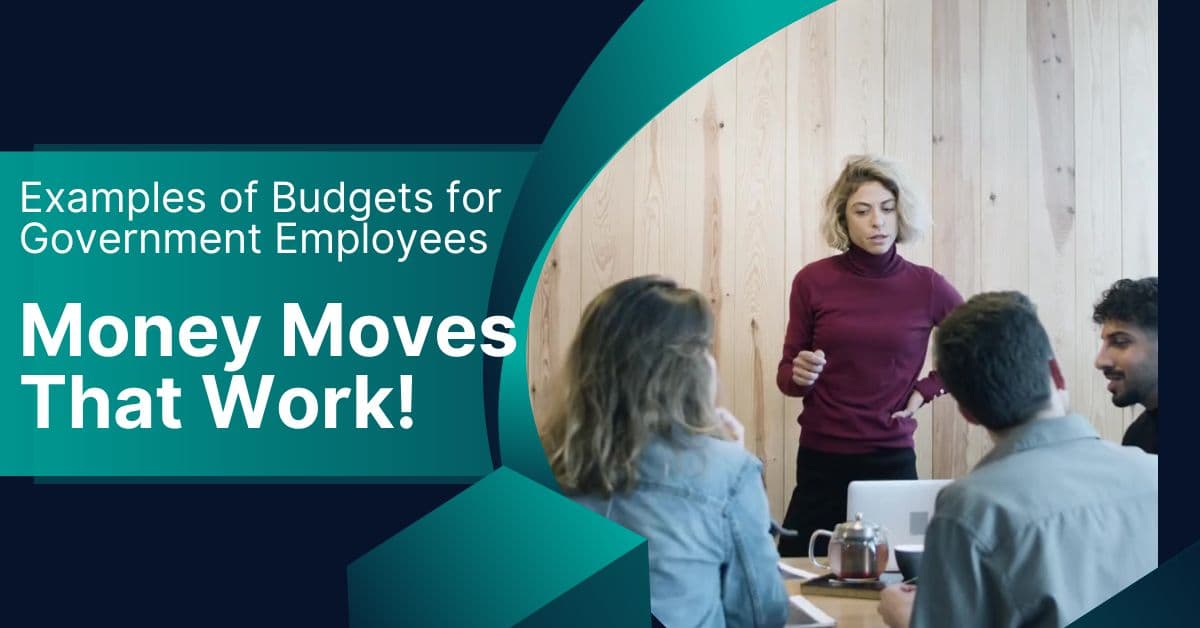Smart Money Moves for Govt Job Holders: Government employment in India are a sought-after ideal, providing millions with security, pensions, and perks. According to Ministry of Personnel projections, there will be over 50 million federal and state government employees by 2025. These positions, which range from railway workers in Kolkata to teachers in Lucknow and IAS officers in Delhi, offer a reliable source of income in a nation where inflation is between 5 and 6%. Nevertheless, many government workers find it difficult to accumulate wealth, save for objectives, or be ready for life after retirement, despite benefits like job stability and allowances. The answer? Smart money strategies are adapted to the particular financial environment of government service.
These techniques are intended for Indian government employees and range from using government programs to prudently budgeting and investing for expansion. Managing money has never been simpler thanks to India’s burgeoning digital economy, which had 14.4 billion UPI transactions in February 2025. Let’s get started right now and explore the wise financial decisions that will safeguard your future!
Why Smart Financial Decisions Are Important for Government Employees
Special perks offered by the government include health benefits (CGHS), pensions (NPS for post-2004 employment), dearness allowances (DA modified biannually), and fixed salary. A 7th Pay Commission clerk makes between ₹35,000 to ₹60,000 plus allowances, whereas a monthly pay of ₹50,000 may increase by 3-5% annually through DA increments. However, difficulties still exist:

- Increasing Costs: Budgets are strained by groceries (₹5,000–₹10,000), rent (₹10,000), and education (₹5,000/month).
- Inflation: 5-6% inflation eats away at savings; by 2030, ₹1 lakh in 2025 will purchase ₹70,000.
- Retirement Gaps: Post-retirement requirements (₹40,000/month) may not be covered by NPS pensions (₹20,000–₹50,000).
- Cultural Pressures: Family support (₹10,000), festivals, and weddings deplete money.
- Debt Traps: Loans with interest rates ranging from 12 to 15% might lead to debt traps.
You benefit from wise financial decisions:
- Maximise Gains: Use CGHS, NPS, or GPF to increase your wealth.
- Construct Savings: ₹5,000 every month at 7% yields ₹8 lakh over a ten-year period.
- Fund Objectives: Home, travel, or children’s education.
- Secure retirement: ₹1 crore corpus by age 60 to provide a secure retirement.
- Reduce Stress: Peace of mind, no debt, and well-defined objectives.
Let’s look at how you might turn your government work into a source of income.
Smart Financial Decisions for Government Employees: A Comprehensive Guide
This comprehensive guide offers 12 useful money moves specifically designed for Indian government workers, along with examples, tips, and doable actions to improve your financial situation.

Step 1: Recognise Your Salary and Benefits
- How to Proceed: Include the following salary components: base pay (₹35,000), benefits (GPF, NPS, CGHS), HRA (₹8,000), DA (50% in 2025, ₹17,500), and allowances (₹5,000).
- Why It Is Important: Clarity displays your wealth—a total of ₹65,000 as opposed to ₹35,000 for basic misleads.
- Deep Dive: By 2026, DA will have increased by ₹1,000, or 3-5% twice a year. The government matches the 10% (₹3,500) deduction from NPS, which comes to ₹7,000 each month invested.
- For instance, Anil, a railway clerk earning ₹50,000, makes ₹45,000 after taxes and ₹7,000 in net profit.
- By April 15, 2025, review your paystub and take note of any perks.
Step 2: Use the 50-30-20 Rule to budget
How to Proceed: Post-tax income divided (for example, ₹45,000 on ₹50,000):
- 50% of needs (rent, food, and expenses) are ₹22,000.
- 30% wants ₹13,500 for gifts and dinner.
- 20% Savings: ₹9,000 (investments, emergencies).
The Reason It Works: Life balance: ₹5,000 saved, ₹10,000 EMI fits.
Hacks: ₹7,000 covers the majority of 20%, therefore NPS qualifies as savings. Reduce “wants” if DA is slower than inflation.
For instance, Priya divides her ₹60,000 into ₹12,000 in savings, ₹18,000 in desires, and ₹30,000 in necessities.
Action: 30 days to test the draft budget before April 20, 2025.
Step 3: Make the Most of Government Programs
- How to Proceed: Make use of LTC (travel reimbursement), CGHS (health cover), NPS (10–12%), and GPF (8% return).
- Why It Is Important: Tax-free, GPF’s ₹5,000 per month at 8% equals ₹12 lakh after 20 years. NPS doubles donations.
- Hacks: Choose an equity-heavy NPS (12% vs. 8% debt), and deliberately increase GPF (by ₹1,000).
- For instance, after ten years, Sunita’s ₹10,000 GPF increased to ₹5 lakh.
- Action: Verify the NPS tier and GPF balance before April 25, 2025.
Step 4: Establish an Emergency Fund
- How to Proceed: In a sweep-in FD (6-7%), save 6–12 months’ worth of spending (₹1.8–₹3.6 lakh on a ₹30,000 budget).
- The Reason It Works: includes medical (₹20,000) and employment moves; there are no loans with a 15% interest rate.
- Hacks: ₹2,000 each month for two years, or ₹48,000. Reduce medical expenses by using CGHS.
- Anil’s ₹3,000 each month, for instance, managed a surgery and saved ₹72,000.
- Action: By April 30, 2025, open an FD with ₹1,000.
Step 5: Begin Growth SIPs
How to Proceed: Invest between ₹2,000 and ₹10,000 each month in stock funds (12% returns, Nifty 50).
Why It Is Important: Funding for children’s education: ₹5,000 per month at 12% = ₹23 lakh after 15 years.
Top Strategies:
- UTI Nifty 50 Index Fund (₹500 SIP, 0.2% cost).
- ₹1,000 SIP, Mirae Asset Large Cap Fund (11–13%).
For instance, in just five years, Priya’s ₹3,000 SIP increased to ₹1.5 lakh.
Take action: by May 05, 2025, begin a ₹1,000 SIP on Groww.
Step 6: Reduce Housing Expenses
- How to Proceed: 20–25% cap on rent/EMI, or ₹10,000–₹15,000 on ₹60,000.
- The Reason It Works: Savings are reduced by the high EMI (₹20,000)—₹40,000 remains compared to ₹50,000.
- Hacks: Use government quarters (₹2,000 vs. ₹10,000), HRA (₹8,000 tax-free), and refinance debts (10% to 8%).
- For instance, Sunita saved ₹24,000 year in taxes because to her ₹12,000 EMI + HRA.
- Take action by May 10, 2025, to claim HRA and investigate quarters.
Step 7: Reduce Utility and Food Bills
- How to Proceed: Set aside ₹2,000–₹3,000 for utilities and ₹5,000–₹8,000 for food.
- The Reason It Matters: ₹1,000 saved equates to ₹1,000 invested, or ₹2.3 lakh over a ten-year period (12%).
- Hacks: Cook (₹50 vs. ₹150/meal), purchase in bulk (dal at ₹50/kg), and get LED lights (₹200 discount).
- For instance, Anil reduced ₹7,000 worth of food to ₹5,000, saving ₹24,000 year.
- Take action by May 15, 2025, to plan meals and save ₹500.
Step 8: Make Retirement Plans Outside of NPS
- How to Proceed: For a ₹1 crore corpus—NPS (₹20,000 pension) + investments—save ₹5,000 to ₹15,000 each month.
- Why It Works: 10% of 10,000 a month is equal to 1 crore after 25 years, or 50,000 a month after 60.
- Hacks: EPF (8.15% for PSUs), SIPs (12%), and PPF (7.1%, ₹1.5 lakh/year).
- Sunita’s ₹5,000 PPF + NPS, for instance, is equal to ₹50 lakh by 60.
- Take action: By May 20, 2025, open a PPF and add ₹1,000.
Step 9: Make Use of Tax Benefits Sensibly
- How to Proceed: Make claims for HRA, 80D (₹25,000—CGHS/health insurance), and 80C (₹1.5 lakh—GPF, PPF).
- Why It Matters: ₹62,400 (30% slab + cess) is saved by ₹2 lakh deductions.
- Hacks: NPS extra (₹50,000, 80CCD(1b)), ELSS (₹50,000, 12% returns).
- For instance, Priya saved ₹46,800 by using ₹1.5 lakh 80C plus ₹50,000 NPS.
- Plan for ₹1 lakh 80C by May 25, 2025, and submit your ITR by July 2026.
Step 10: Reduce Lifestyle Infiltration
- What to Do: Spend between ₹5,000 and ₹15,000 on electronics, travel, and food.
- The Reason It Works: Savings are reduced by ₹20,000 “wants” on ₹60,000; ₹10,000 frees ₹1.2 lakh annually.
- Hacks: share OTT (₹200 vs. ₹500), LTC for holidays (₹20,000 refunded), and sales (₹1,000 off).
- For instance, Anil gave SIPs ₹15,000 to ₹8,000 to ₹84,000 year.
- Action: Use Walnut to track; set a ₹5,000 limit by May 30, 2025.
Step 11: Arrange Family and Festive Activities
- What to Do: Set aside ₹2,000–₹5,000 every month for weddings and Diwali (₹24,000–₹60,000 annually).
- Why It Counts: Prevents credit (36% interest)—10,000 planned contributions as opposed to borrowed.
- Hacks: Early purchases (₹100 discount) and homemade presents (₹200 instead of ₹500).
- For instance, Sunita saved ₹36,000 for a wedding, or ₹3,000 a month.
- Take action by June 05, 2025, to begin the joyful fund.
Step 12: Protect and Insure
- How to Proceed: Obtain health top-up (₹10 lakh, ₹5,000/year) and term insurance (₹1 crore, ₹10,000/year).
- The Reason It Works: Protects family— if you’re away, ₹50,000 every month; CGHS + top-up pays ₹20,000 in costs.
- Hacks: Star Health top-up (₹4,000) and LIC term (₹8,000/year). Make a claim 80D.
- For instance, Priya’s ₹10,000 term is equivalent to ₹1 crore in cover—peace for ₹833/month.
- Take action by purchasing a term plan by June 10, 2025.
Examples of Budgets for Government Employees

Salary: ₹30,000 (Clerk, Tier-2 City)
- Income (NPS, post-tax): ₹29,000.
- 50% of ₹14,500 is needed (₹7,000 for rent, ₹4,000 for food, ₹1,500 for utilities, and ₹2,000 for other expenses).
- Thirty percent wants: ₹8,700 (gifts, dinner).
- ₹5,800 in savings (20%) (₹2,800 emergency, ₹1,000 SIP, and ₹2,000 GPF).
The salary of a Metro officer is ₹60,000
- Income (NPS, post-tax): ₹54,000.
- 27,000 is needed (50%) (12,000 for EMI, 6,000 for food, 3,000 for utilities, 3,000 for fees, and 3,000 for transportation).
- Thirty percent wants: ₹16,200 (vacation, enjoyment).
- ₹10,800 in savings (20%) (₹2,800 PPF, ₹3,000 SIP, and ₹5,000 NPS).
Advantages of Smart Money Moves
- Wealth: ₹1 crore over 25 years at a 10% annual rate of ₹5,000 each month.
- Security: insurance, emergency fund—no surprises.
- Tax savings with 80C and 80D: ₹50,000 to ₹1 lakh annually.
- Retirement: ₹50,000 per month after age 60, including investments and NPS.
- Balance: Travel with LTC and take in the festivities.
Examples from Real-Life
The stability of Anil’s railway
Anil, a 35-year-old Patna clerk who makes ₹40,000 a month:
- Needs: ₹20,000 for food and rent.
- Family wants ₹10,000.
- ₹2 lakh over five years—₹3,000 SIP plus ₹5,000 GPF—was saved.
- He claims, “My dreams are funded by my job.”
Priya’s Growth at PSU
Mumbai manager Priya, 42, makes ₹80,000 a month:
- Required: ₹40,000 (fees, EMI).
- Desires: ₹20,000 (tourism).
- Over seven years, ₹10 lakh was saved (₹10,000 NPS + ₹5,000 PPF).
- “Clever moves work,” she says.
Sunita’s Teaching Plan
Sunita, a 38-year-old Pune-based educator who makes ₹50,000 a month:
- Needs: ₹25,000 for food and expenses.
- Desires: ₹12,000.
- Savings: ₹1 lakh over three years (₹3,000 SIP plus ₹5,000 emergency).
- “I’m ready to retire,” she says.
Additional Advice for Government Employees
- DA Hikes: Save half of the 1,000 rise, or 6,000 annually.
- LTC Hack: Get a family vacation for free by claiming ₹20,000 in travel.
- Digital Tools: ClearTax (ITR) and PhonePe (tracking).
- Side income: coaching for ₹2,000 per month, or ₹24,000 annually.
- Wishfin offers a free CIBIL check for loans above 750.
- Family Plan: Save an additional ₹5,000 by synchronising finances.
- Learn: Look for advice on YouTube (e.g., CA Rachana Ranade).
Typical Problems and Their Solutions
- Problem: Pay stagnation (3% rise) is the challenge.
Solution: The answer is to invest ₹2,000 SIP; 12% outpaces 5% inflation. - Problem: High EMIs (₹15,000) are a challenge.
Solution: Save ₹2,000 by refinancing (10% to 8%). - Problem: No habit of saving money.
Solution: Force the ₹1,000 SIP auto-debit. - Problem: Family demands are a challenge.
Solution: Specify objectives and cap “wants” to ₹5,000. - Problem: Fears of retirement provide a challenge.
Solution: The solution is ₹50 lakh by 60, or ₹5,000 PPF plus NPS.
Why These Steps Are Effective for Government Employees
India’s foundation is made up of 50 million government jobs:
- Stability: Budgeting is predictable when fixed salary and DA are combined.
- Perks: Benefits include built-in wealth instruments like CGHS, NPS, and GPF.
- Digital Edge: 70 million people make money easier with UPI and apps.
Resources and Tools
- Apps: ClearTax (tax), Walnut (tracking), and Groww (SIPs).
- Websites: Moneycontrol (advice) and NPS Trust (pension).
- Free resources: include YouTube instructional and Google Sheets budget templates.
- Communities: For peer guidance, visit r/IndiaInvestments.
Make Your First Wise Financial Decisions Now
Now take control of your finances:
- Pay list due date: April 15, 2025.
- By April 25, 2025, budget.
- Before May 05, 2025, save ₹1,000.
Drive your government employment wisely since it is a wealth generator. To encourage financial savvy, share this information with family members or co-workers. All government employees can prosper with these actions!
Smart Saving Tips Every Indian Housewife Must Know
Smart Money Hacks for Indian Government Employees: A Step-by-Step Guide!
How to Use PhonePay Smart Savings for Daily Goals

